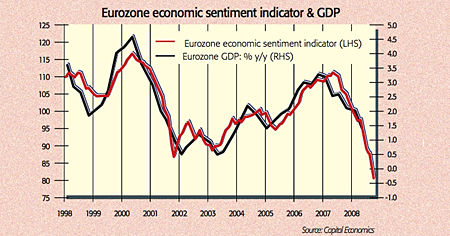
“Grim.” There’s no other word for the European Commission’s autumn economic outlook, says Matthew Curtin in The Wall Street Journal. It has given up on the idea that Europe could shrug off the global downturn and now says output in the eurozone is likely to have declined in the third quarter after shrinking in the second (two successive quarters of falling output marks a recession) and will expand by just 0.1% next year. Britain, meanwhile, is set to endure the worst slide in output next year of all EU countries, barring Estonia and Latvia.
Even this forecast of barely positive growth next year looks optimistic, given the latest awful data. German business confidence tumbled to a five-year low last month. A sub-index measuring expectations for the next six months was at its lowest since the early 1990s. A eurozone survey gauging executive and consumer confidence has plunged to a 15-year low. European retail sales have slid for five months in a row. Spanish car sales tumbled to a 13-year low last month as the burst housing bubble sent growth below the zero line. And eurozone manufacturing activity and export orders have sunk to record lows.
Moreover, says Capital Economics, the recent spike in interbank lending rates raises the risk of an even sharper slowdown in credit growth than we’ve seen so far; the credit crunch is yet to have “its full impact on domestic demand”. Year-on-year growth in loans to households is already down to 4%. European interest rates are set to slide sharply, but this can’t stop the eurozone economy contracting by 1% next year amid the worst global recession since 1945.
As the recession takes hold, there are further losses ahead for banks. As Citigroup recently pointed out, corporate debt levels have risen sharply in the eurozone over the past few years and Ruth Sunderland in The Observer points to the fact that last year over 25% of corporate debt in Britain was accounted for by firms that don’t make enough profit to service their interest bill.
Stephen Jen of Morgan Stanley says that European banks are five times more exposed to emerging markets than their US or Japanese counterparts. European banks account for $4.7trn of cross-border loans to emerging markets, according to Brown Brothers Harriman’s Marc Chandler. Plunging currencies in eastern Europe in particular have highlighted the risk of default as local consumers who borrowed in foreign money face a squeeze on their income.
So far in this credit crisis we have seen “the damage banks wreaked on each other”, as Sunderland puts it; now losses stemming from the weakening economy are on the cards. None of this bodes well for bank lending.
So what next for European stocks, which have recovered their poise after the latest brutal sell-off – the pan-European DJ Stoxx 600 index is around 12% up from its five-year low of late October? Many strategists reckon that a nasty earnings slide is priced in – Morgan Stanley thinks the market is discounting a peak-to-trough fall in earnings per share of 43% – and that no-one is paying attention to analysts’ still-optimistic forecasts (pan-European profits are still expected to grow by 9% next year).
Yet stocks that miss their forecasts still take investors by surprise, says Tony Jackson in the FT. Shares in UK engineer GKN tumbled by 10% last week, even though the fact that car sales are collapsing is hardly news. And Ian Harnett of Absolute Strategy expects an overall profit slide of at least 50% as high margins contract: Europe remains vulnerable to earnings disappointments and another down-leg. Valuations may be cheap, but look set to get cheaper. As Tony Jackson puts it in the FT, “there is no reason to think the worst is over”.